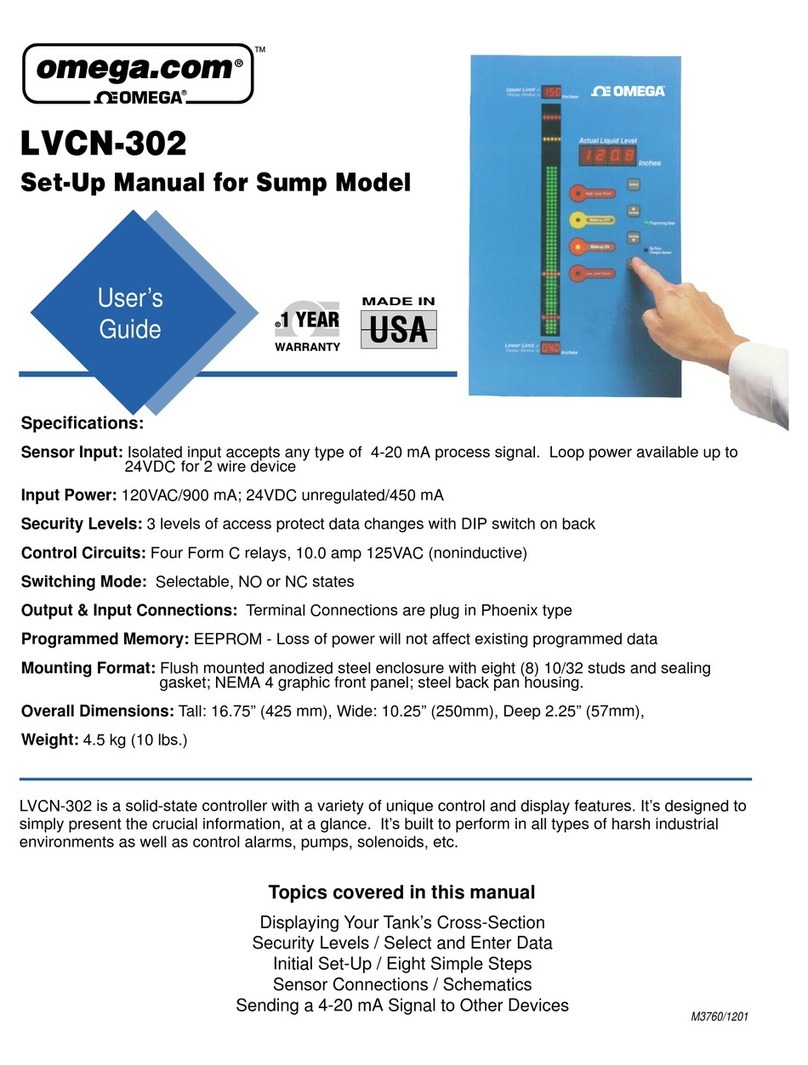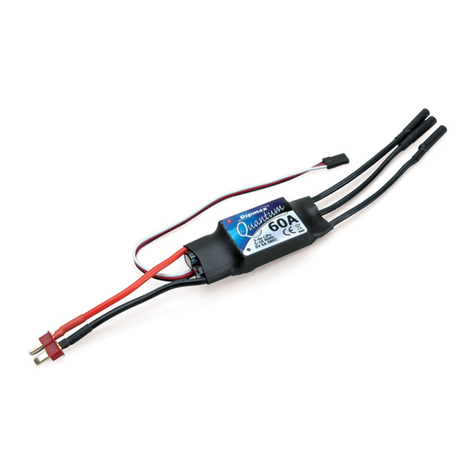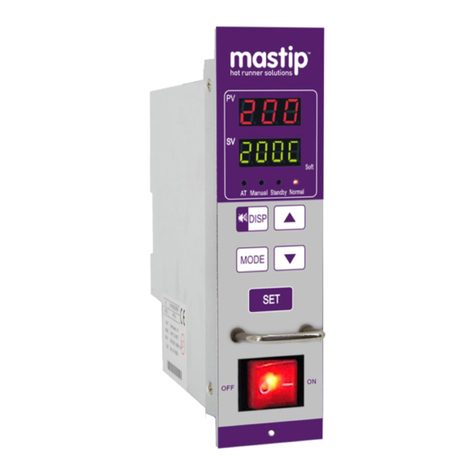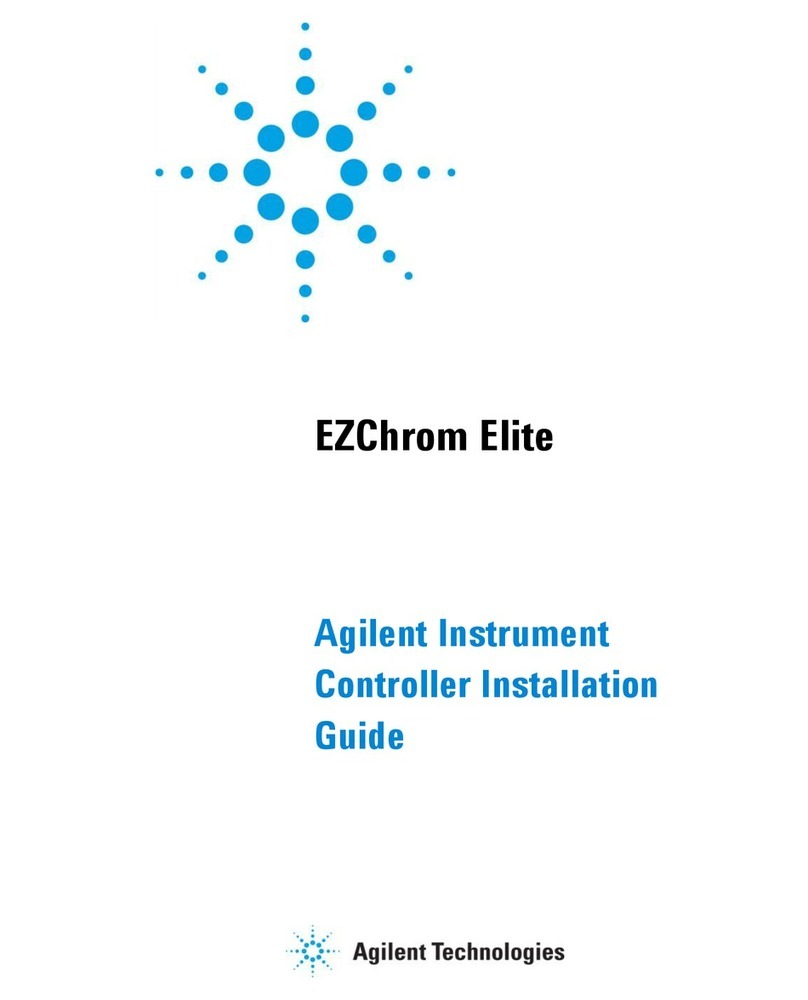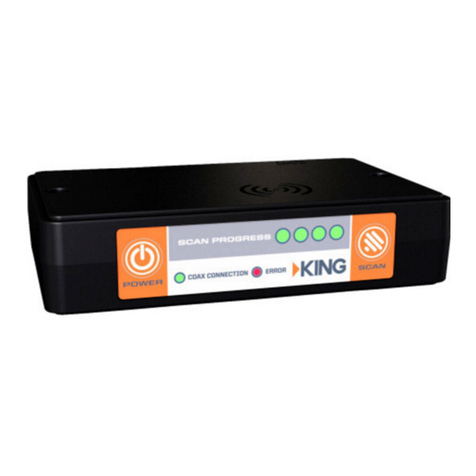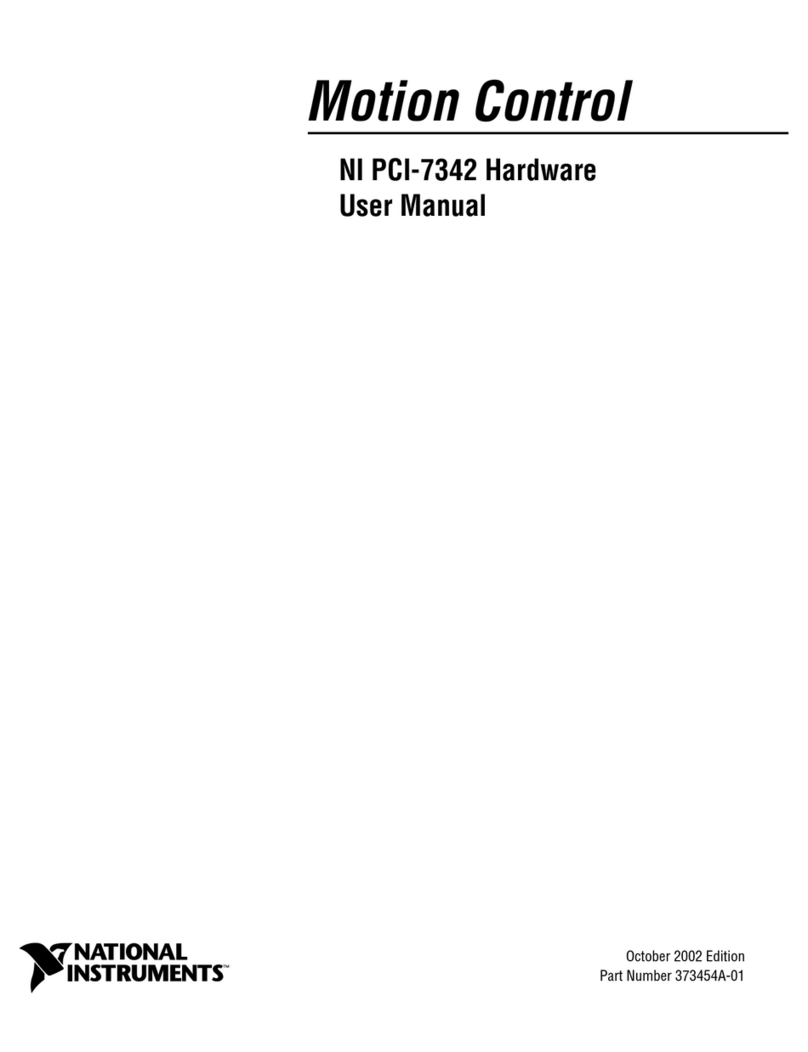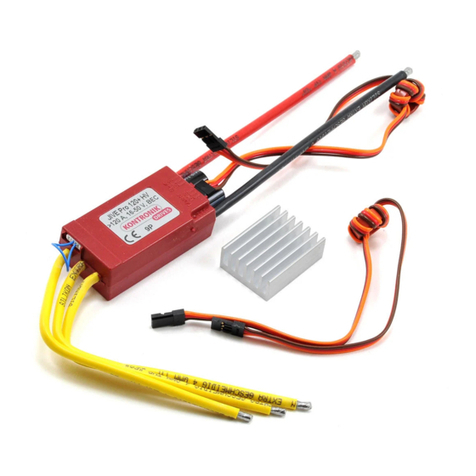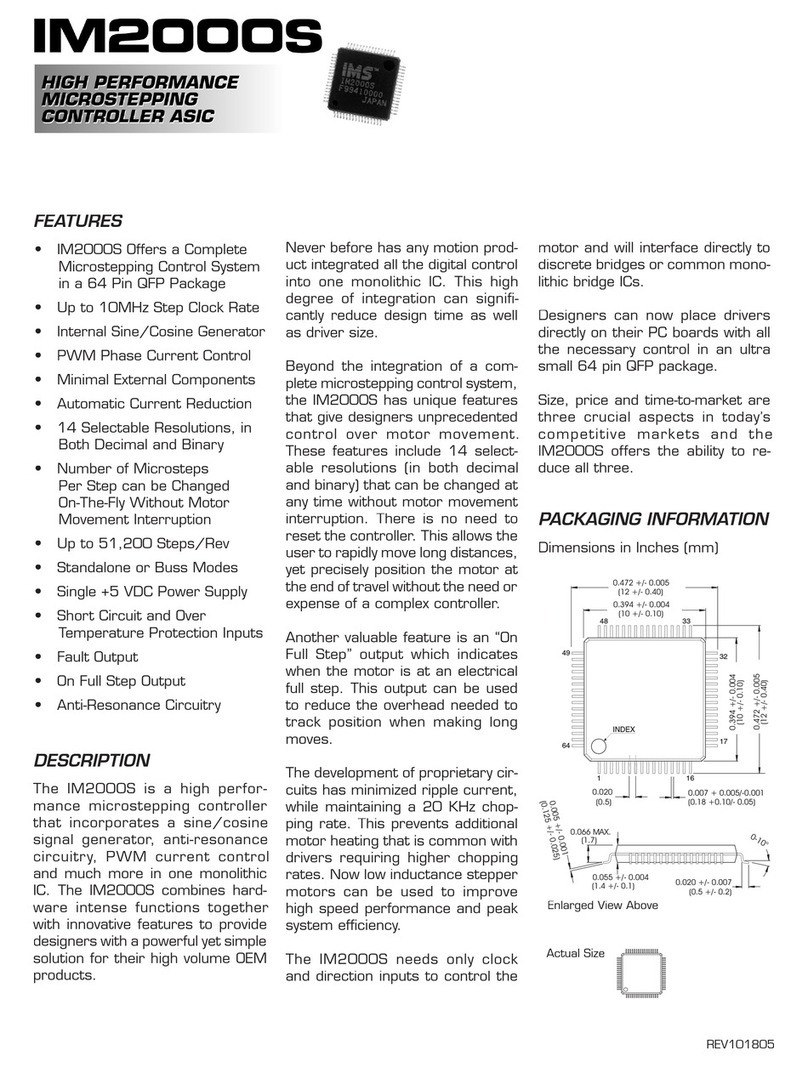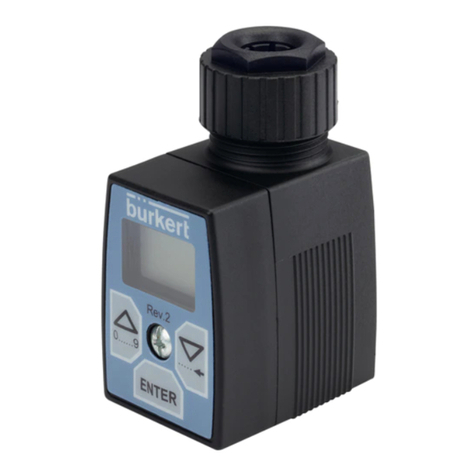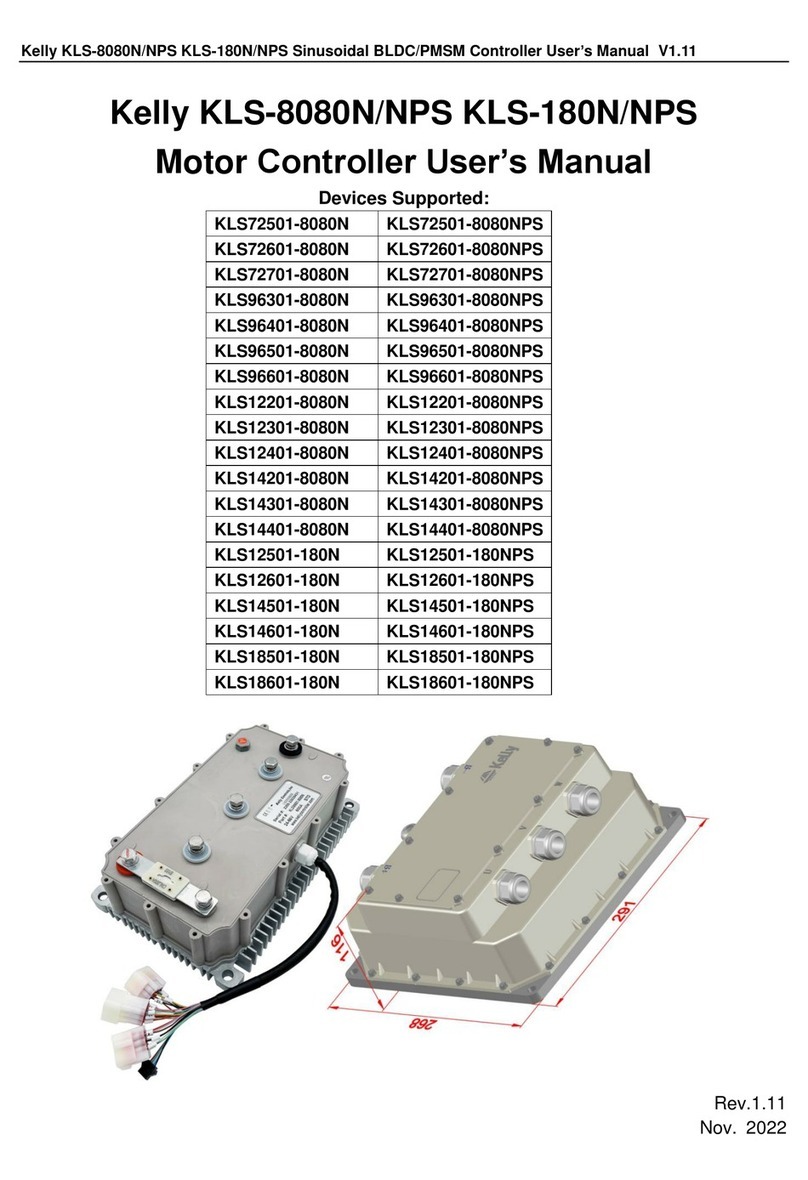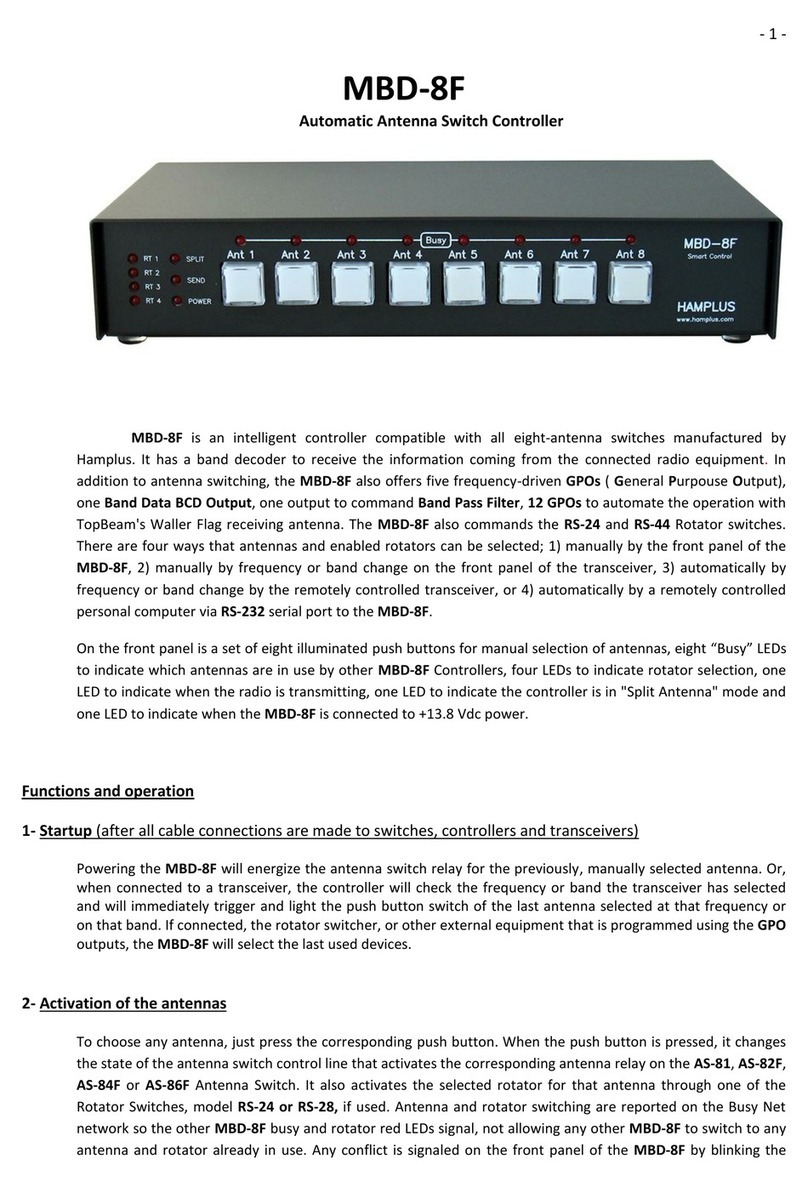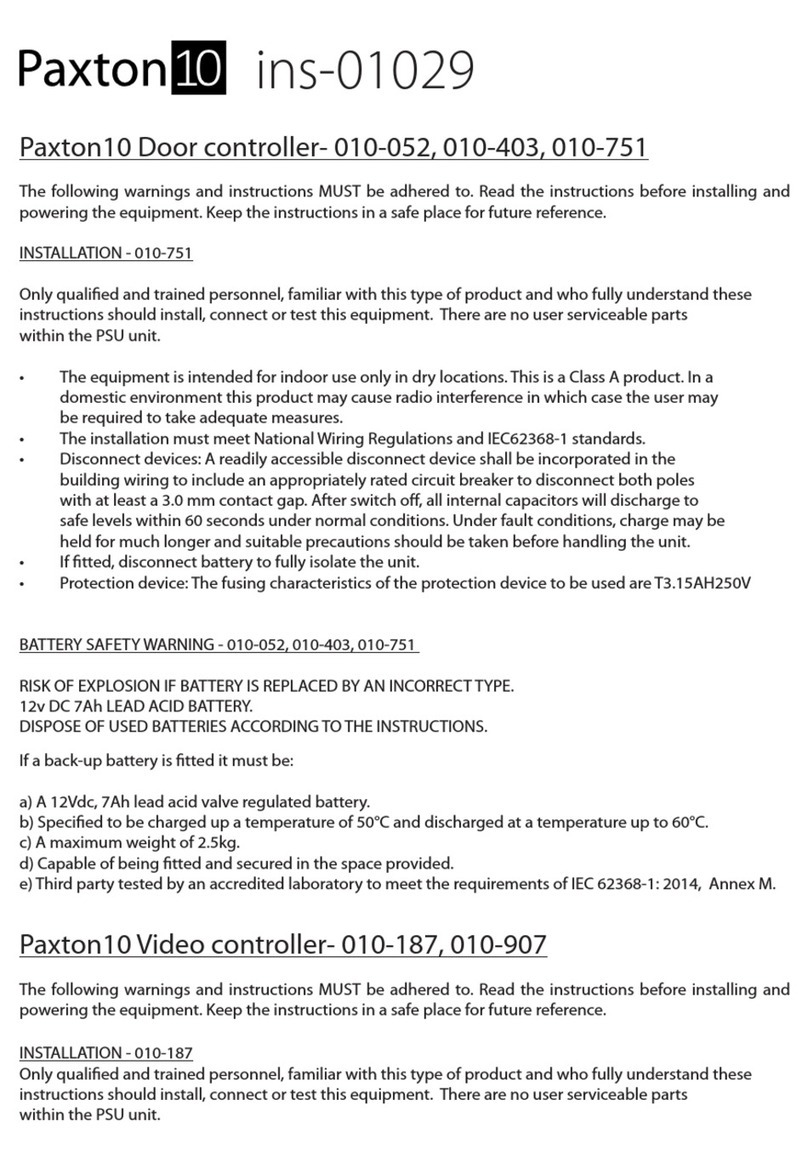Nextron MASTERTRACE User manual

MASTER
TRACE
TM
OPERATOR’S MANUAL
HEAT TRACING CONTROL

MASTER
TRACE
Contents
1 Overview .....................................................................................................................................1.1
1.1 Use of This Manual .............................................................................................................................................. 1.1
1.2 Related Documents ............................................................................................................................................. 1.1
1.3 Conventions ......................................................................................................................................................... 1.1
1.4 Scope ................................................................................................................................................................... 1.1
1.5 Rev.A Enhancements ........................................................................................................................................... 1.1
1.6 Overall Enhancements ........................................................................................................................................ 1.1
1.7 Shipping Content ................................................................................................................................................. 1.1
1.8 Theory of Operation.............................................................................................................................................. 1.2
2 Getting Started ...........................................................................................................................2.1
2.1 Introduction........................................................................................................................................................... 2.1
2.2 Enable Heaters .................................................................................................................................................... 2.1
2.3 Enter Setpoints..................................................................................................................................................... 2.2
2.4 Test Heater & Alarms ........................................................................................................................................... 2.4
2.5 Monitor System Status.......................................................................................................................................... 2.4
3 Product Description ...................................................................................................................3.1
3.1 Introduction........................................................................................................................................................... 3.1
3.2 Features and Benefits.......................................................................................................................................... 3.2
3.3 Control Module Specifications ............................................................................................................................. 3.3
3.4 Model Codes for Control Panels ....................................................................................................................... 3.19
4 Installation ...................................................................................................................................4.1
4.1 Control Panel Mounting ....................................................................................................................................... 4.1
4.2 RTD Sensor Wiring .............................................................................................................................................. 4.1
4.3 Ground Fault Protection ....................................................................................................................................... 4.1
4.4 Ground Fault Testing............................................................................................................................................ 4.1
4.5 Power and Heater Wiring..................................................................................................................................... 4.1
4.6 Ground Connection.............................................................................................................................................. 4.1
4.7 Safety Ground....................................................................................................................................................... 4.2
4.8 Control Power Wiring ........................................................................................................................................... 4.2
4.9 Commissioning ................................................................................................................................................... 4.2
5 Operation.....................................................................................................................................5.1
5.1 Control Modules .................................................................................................................................................. 5.1
5.2 Interface Modules - ML100 & MR100 .................................................................................................................. 5.6
5.3 Responding to Alarms ........................................................................................................................................ 5.9
5.4 Setpoint Values Menu: Single-Phase Modules ................................................................................................ 5.10
5.5 Setpoint Values Menu: Three-Phase Modules (1- and 5-point only).................................................................5.11
5.6 Measured Values Menu: Single-Phase Modules ............................................................................................ 5.12
5.7 Measured Values Menu: Three-Phase Modules .............................................................................................. 5.13
5.8 Interface Module - MR100 for Windows CE ...................................................................................................... 5.14
6 Programming & Setup ................................................................................................................6.1
6.1 Getting Started ...................................................................................................................................................... 6.1
6.2 Program Enable ................................................................................................................................................... 6.1
6.3 Module List/Communication Map ........................................................................................................................ 6.1
6.4 Heater Enable ...................................................................................................................................................... 6.1
6.5 Example: Change the Setpoint for Heater 3-2 to 50°C ....................................................................................... 6.1
7 Networking Modules ..................................................................................................................7.1
7.1 RS-485 Communications in Modbus RTU ......................................................................................................... 7.1
7.2 RS-485 Wiring ...................................................................................................................................................... 7.1
7.3 Removing a Control Module from the Network ................................................................................................... 7.1
7.4 Adding a Control Module to the Network.............................................................................................................. 7.1
7.5CommunicationWithThird PartyEquipment ..................................................................................................................7.1
7.6 Baud Rate ............................................................................................................................................................ 7.3
7.7 Ethernet Communication in Modbus TCP and MasterTrace Heat Tracing Panel Option “ETH”........................ 7.3

ContentsMASTER
TRACE
7.8 Ethernet Communication in EtherNet/IP ............................................................................................................. 7.3
7.9 MC100 for Internet ................................................................................................................................................ 7.4
8 Service & Testing .......................................................................................................................8.1
8.1 Troubleshooting Hints ......................................................................................................................................... 8.1
8.2 Field Tests ............................................................................................................................................................ 8.1
8.3 Field Repairs........................................................................................................................................................ 8.2
Appendix A Display Message Details - Setpoints ...................................................................... A.1
Setpoints: Operating Values ...................................................................................................................................... A.1
Setpoints: Heater Setup Menu ................................................................................................................................... A.6
Setpoints: System Setup Menu.................................................................................................................................. A.8
Setpoints: Test Menu................................................................................................................................................ A.17
Appendix B Display Message Detail - Measured ......................................................................B.1
Measured Values: Operating Values ......................................................................................................................... B.1
Measured Values: Statistics Menu ............................................................................................................................. B.3
Appendix C Summary of Alarms and their Causes .................................................................... C.1
Appendix D Typical Wiring Diagrams ..........................................................................................D.1
MS-1DXH0 ..................................................................................................................................................................D.1
MS-1DIN2 ...................................................................................................................................................................D.1
MS-1TXH0 ..................................................................................................................................................................D.1
MS-2DXH0 ..................................................................................................................................................................D.2
MS-2DIN2 ...................................................................................................................................................................D.2
MS-5ADXH0................................................................................................................................................................ D.2
MS-5ADIN2 .................................................................................................................................................................D.3
MS-5ATXH0.................................................................................................................................................................D.3
MS-10ADXH0..............................................................................................................................................................D.4
MS-10ADIN2 ...............................................................................................................................................................D.4
MS-10ADIN2T.............................................................................................................................................................D.5
MS-10ADIN2X .............................................................................................................................................................D.5
Driving Contactors......................................................................................................................................................D.6
Serial Communication 1 ............................................................................................................................................D.6
Serial Communication 2 ............................................................................................................................................D.7
Appendix E Freeze Protection .................................................................................................... E.1
Appendix F Wireless and Wired RTD .......................................................................................... F.1
Appendix G MR100 for Windows CE........................................................................................... G.1
Warranty .......................................................................................................................... Back Cover

MASTERTRACE
1.1
Chapter 1 Overview
1 Overview
1.1 Use of This Manual
Reading a lengthy instruction manual on a new product is
not a task most people enjoy. To speed things up,
Chapter 2, Getting Started, provides a step-by-step
tutorial for a heat trace application. Chapter 4, Installa-
tion, discusses important mounting and wiring issues for
reliable operation. Detailed information relating to switch
and output ratings, accuracy and so forth are detailed in
Section 3.3, Specification. The remainder of this manual
should be read and kept for reference to provide the
maximum benefit of the MasterTrace Controls.
1.2 Related Documents
The following documents are attached with this manual
and located inside the control panel.
sLayout Drawing(s)
sWiring Diagram(s)
1.3 Conventions
The following conventions are used in this manual.
?User Changeable Values
&Retrieved Data
[ ] Key Press
V~VAC (AC Voltage)
_ _ _ VDC (DC Voltage)
Warning Statement
1.4 Scope
This manual describes control panel installation, startup
information and operation for:
sMasterTrace one and two point control modules
sMasterTrace Rev.A versions of five and ten point
modules. These models are identified by the addition of
the letter A in the model number. (ie: MS-AD,
MS-10ADXH0). These models are not replacement
compatible with previous models.
sMasterTrace local and remote display modules
1.5 Rev.A Enhancements
New enhanced Rev.A models have been introduced for
five and ten point models. These models include MS-
5ADXH0, MS-5ATXH0, MS-5ADIN2, MS-10ADXH0
and MS-10ADXH0 which replaces the previous models
designated without the A.
A GF test function has been added to verify that GF
monitoring is functional. The user may set the GF testing
period and is notified if a GF test fails. GF monitoring is
very important in protecting plant equipment in the event
of a GF which can cause fires . It is required by electrical
code (NEC and CEC) on electric heat trace.
The overall height on external switching models MS-
5ADXH0, MS-5ATXH0 and MS-10ADXH0 have been
reduced by half from the previous models which will
improve control panel servicing.
Service and replacement of control modules take minutes
instead of hours with the addition of detachable terminals.
All terminals can be unplugged without a screw driver.
1.6 Overall Enhancements
These enhancements pertain to all controller models
described in this manual. These controllers are identified
by the marking REV. D1-xx-xx on the product
nameplate. Previous models identified by the marking
REV. D-xx-xx on the product nameplate do not
contain these enhancements.
Alarm contacts have been changed on all controller
models to one solid-state and one mechanical alarm
contact. Each contact may be configured normally open
or closed by the user. The mechanical contact is dual
rated hazardous and ordinary areas. The alarm light
indicator can be programmed by the user to turn on, off
or flash on alarm.
Communication baud rate is user settable to one of the
following: 600,1200, 2400, 4800 and 9600. Faster baud
rates will provide quicker response times on the remote
display.
The MS-xDXN0 type models which were used for
external contactor drive instead of solid-state relays are
discontinued for new applications. The MS-xDXH0 or
MS-xADXH0 models which are used for external solid-
state relays can also be used for driving contacts with the
addition of the SSR/HCC board. More details on driving
contacts with this board is shown in Appendix D, page
D6.
1.7 Shipping Content
Control panels are usually packaged in a wooden crate,
sealed in plastic to minimize possiblity of damage. Check
the crate for damage, or other signs of rough handling or
abuse. If damaged, notify the shipping carrier at once.
Control Panel
Panel Drawings (Located inside the control panel)
Instruction Manual (Located inside the control panel)
Warranty Card (Located inside the control panel)

1.2
MASTERTRACE Chapter 1 Overview
1.8 Theory of Operation
Controller functions are controlled by a microprocessor
that measures all analog signals and logic inputs, control
heater outputs and alarm contacts, and reads all user
input including communications and outputs to the
faceplate display and LEDs. The remainder of this chapter
describes the algorithms and operation of some of the
controller functions.
RTD Sensing
An RTD changes its resistance in a precision relationship
to temperature. This resistance is sensed by passing a
constant current through the RTD and measuring the
resulting voltage across the RTD (resistance = voltage/
current). The voltage appearing across RTD terminals also
includes the resistance of the inter-connecting wiring to
the RTD, which varies with wire length, size and ambient
temperature. By using a three-wire sensing scheme and a
lead resistance compensation circuit, the lead resistance
is cancelled out to give a voltage proportional to the true
RTD sensor temperature.
RTDs respond in a known but non-linear fashion to
temperature, which if uncorrected could lead to significant
errors over the temperature range of the controller.
Consequently, some means are needed to convert the
input voltage to a linear and useful range. The CPU
applies gain, offset and non-linearity corrections through
a linearization algorithm.
Current, Ground Fault and Voltage Sensing
Current transformers and high impedance voltage dividers
are used to scale-down the incoming heater current,
ground fault current and voltage. All three signals are
then passed through a full wave rectifier and filter to
obtain a DC signal. The DC signals are then converted to
digital values by a 10 bit A/D converter before finally
being passed on to the CPU for analysis.
Each of the three DC signals are sampled 300 times with
zero cross synchronization so that the sampling covers an
exact span of ten power cycles. This is to ensure that
heater current values are consistently measured when the
heater output cycle is modulated by the powerlimit and
proportional control functions.
Powerlimit
The powerlimit function allows the heater to operate
below its rated power by cycle modulation. Cycle
modulation is accomplished by controlling the integral
number power cycles into the heater over a periodic time
frame. The MasterTrace control uses a ten cycle time
frame. The integral number of power cycles per time frame
is called a duty cycle. With a ten cycle time frame, there
are ten duty cycles possible. For each duty cycle, there is
a fixed pattern that defines the number of power cycles in
which the heater is on and off. This is shown in figure 1.1.
Figure 1.1 Cycle Modulation - 10 Cycle Frame

MASTERTRACE
1.3
Chapter 1 Overview
Cycle modulating the current through the heater has the
effect of turning the heater on and off rapidly and
therefore, power output is reduced in the long run. Since
the switching is zero-cross controlled, the controller
knows exactly when power cycles start and finish. Zero-
cross switching also helps reduce power harmonics that
generate unnecessary interference.
The heater current (average current) measured by the
controller while cycle modulation is in effect may be
approximated as follows:
Heater Current at 100% x Duty Cycle = Average Current
When powerlimit is enabled, a powerlimit current is set by
the user. This is essentially the desired average current.
The powerlimit control algorithm ensures that the actual
average current will not exceed the powerlimit setting
while optimizing the maximum duty cycle possible. When
the average current exceeds the powerlimit setting, the
duty cycle is reduce by 10%. When the average current is
below the powerlimit setting, the duty cycle is increased
by 10%. Before the algorithm increases or decreases the
duty cycle, the controller waits until the heater current
has reached steady-state at the current duty cycle setting.
If the heater is initially off and the controller calls for heat,
the duty cycle starts at zero and increases by 10%
increments until it reaches a steady-state value. This
ramping up effect provides a current-driven softstart
whenever the controller calls for heat.
Proportional Control
Unlike on/off control where the heater is fully on or off,
proportional control can partially turn on the heater. The
heater output is proportional to the difference between
actual temperature and heater setpoint. The relationship is
expressed as follows:
(actual temperature heater setpoint) x k = heater output
where k is the proportional gain
To partially turn on the heater, the proportional control
function uses cycle modulation in the powerlimit function.
By incorporating cycle modulation into the proportional
control equation, the algorithm is expressed using the
Equation 1.
The deadband factor DB(t) is a time constant that
determines the slope of change of the proposed heater on
duty cycle with the temperature difference. It is adjusted
between 1 to 10 each hour to minimize the difference
between the measured temperature and the temperature
secondsintime
C)(
C)(peratureheater tem
C)(emperaturesetpoint theater
cycle)C/duty(infactordeadband)(
cycleduty)(Where
)()(1)(
(1))()(0
)(
)(
0)(0)(
=
°==
°=
°=
°=
=
³=
<<=
£=
t
TTs-T(t)e(t)
T(t)
Ts
tDB
td
tDBteiftd
tDBteif
DB(t)
te
td
teiftd
setpoint. Every hour after power up, the controller
calculates the absolute values of the temperature
differences e(t) and sums them during the hour. Then the
total absolute temperature difference is divided by the
number of temperature readings taken during the hour.
The result is called the Average Absolute Temperature
Difference (AATD) for the hour. If current AATD is
smaller than the AATD in the previous hour, the
deadband factor will be increased or decreased in the
same direction. If current AATD is larger than the AATD
in the previous hour, the deadband factor will be
increased or decreased in the reversed direction. At
steady state, the deadband factor used will fluctuate
around a optimum value.
Figure 1.2 shows the relationship between the proposed
heater on duty cycle and the temperature difference for
different deadband factors used.
Figure 1.2 Proportional Control
Duty Cycle vs. Temperature Difference

1.4
MASTERTRACE Chapter 1 Overview
On/Off Control with Deadband
The default control mode of MasterTrace control is
deadband control or simply on/off control with the
proportional control setting turned off. On/off control
without deadband (that is deadband set to 0 C° or 0 F°;
note that these units denote the temperature differential
with ° placed to the right of the unit) means that the
heater turns on when actual temperature is below setpoint
and turns off when above setpoint. However, this causes
oscillations when the actual temperature is very close to
setpoint. To eliminate oscillations, hysterisis is applied to
the on/off control by a deadband value. The on/off
control with deadband operation is described by the
hysterisis curve in figure 1.3. Assume that actual
temperature is well below (setpoint - deadband setting),
the controller calls for heat. As the actual temperature
rises, the controller continues to call for heat until the
actual temperature has reached (setpoint + deadband
setting). The controller no longer calls for heat and the
heater is off. As the actual temperature cools, the
controller does not call for heat until the actual
temperature reaches (setpoint deadband setting). The
hysterisis effect is controlled by the momentum of the
actual temperature rather than the temperature value itself.
Figure 1.3 On/Off Control with Deadband

MASTERTRACE
2.1
Chapter 2 Getting Started
2 Getting Started
2.1 Introduction
MasterTrace™ has many features which can provide trou-
ble-free operation of heat tracing installations. To realize all
the capabilities of control, it is recommended that all sec-
tions of the instruction manual are read.
An example is presented to illustrate how MasterTrace™
set up and operation on a specific installation.
MasterTrace™ is easy to program and setting up a unit to
your specific requirements should be straight forward.
n this example an MS-10A control module and ML100/
MR100 front panel display/keyboard module are mounted
in an enclosure for control of 10 heavy oil feed lines. Con-
sult Appendix A and B for further information on a specific
message or instructions.
Important Note:
For the programming of MasterTrace™ panel with an
MS-10A control module and MR100 for Windows C
Touch Screen remote monitoring module, the same proce-
dure outlined in this example applies. Consult Appendix
G - MR100 for Windows C for further information.
Example: Each heater will be programmed as:
Configuration:
1) 10 point panel and local display
2) 1 RTD per heater for temperature sensing
3) Mineral insulated (M ) cable is used for the heater.
4) Normally open alarm contact to remote programmable
control
5) Solid state switching 120 Vac@20A
6) Northern climate installation outdoors.
Operating temperatures: -40° to +40 °C
NEMA-4 weatherproof enclosure.
nstall and commission the control in the following order:
STEP 1: Enable heaters (Section 2.2)
STEP 2: Program setpoints (Section 2.3)
STEP 3: Test heater and alarm operation (Section 2.4)
STEP 4: Monitor system status (Section 2.5)
2.2 Enable Heaters
After each control has been programmed with it’s unique
address, it is necessary to indicate which units are con-
nected to the system and should be controlled. This is done
by enabling a heater circuit. To enable a heater circuit, the
operator must specify the heater number.
Note: When programming controls on a multipoint system
it is important that you always know which heater is being
accessed. Otherwise it is possible to program the wrong
heater control by accident.
Suppose in our example we have a 10-point controller with
heaters; 1-1, 1-2, 1-3 and 1-4 wired and programmed. The
remaining six unused heaters will be disabled and can be
used for easy system expansion at a later date.
The user can determine which heater the display is selected
to by pressing either the [SETPO NTS] key or the [MEAS-
URED] key which will cause this message to be displayed
(the 2nd line and heater number may be different):
SELECT HEATER: 1-1
NONAME
Use the [VALUE ×] or [VALUE Ø] keys to select the appro-
priate heater number then press [STORE] to select a new
heater.
For this example, press [SETPO NT], select heater 1-1 using
[VALUE ×] or [VALUE Ø] keys then press [STORE].
Setpoint Required Range
Fluid maintain
temperature
50 °C 0-500°C/off
/none
Low temperature
alarm
35 °C -50 to 500°C/off
High temperature
alarm
no alarm -50 to 500°C/off
Nominal heater
current
5 amps 0.0 to 100.0A
/off
Nominal heater
voltage
115 VAC 100 to 600 Vac
Ground fault trip
current
30 mA 10 to 1000mA
/off
Ground fault alarm
current
20 mA 10 to 1000mA
/off
System exercise
time interval
8 hours 1-24/off
Cost per Kilowatt
hour
$0.06 $0.01-$0.50
Heater name HEAVY O L
L NE
16 characters

2.2
MASTERTRACE Chapter 2 Getting Started
To enable a heater circuit, press the [SETPO NTS] key once
to access the Setpoints Operating Values group of mes-
sages. Press [MESSAGE Ø] until a message similar to the
following appears:
HEATER ENABLED?
NO"
Use [VALUE ×] or [VALUE Ø] keys to toggle Heater 1-1
between YES and NO. When YES is displayed, press
[STORE].
Repeat this process, for the remaining heaters. For example,
to enable heater 1-2, select heater 1-2 first, then press the
[MESSAGE Ø] key to display:
HEATER ENABLED?
NO"
Select YES, then press [STORE] to enable heater 1-2.
Now that we have programmed control addresses and told
the master display which heater circuits are enabled, we can
program setpoints for each control. There are two ways to
do this on a multipoint system. Either go through each
control and program every value or choose a parameter like
temperature and program each control with that parameter
before proceeding with the next item.
2.3 Enter Setpoints
2.3.1 Program Enable: Since the heater control display and
keypad are normally accessible to passers-by who may wish
to read measured values, a program disable feature is used
to prevent accidental changes to the setpoints. So before
any setpoints can be entered, the PROGRAM ENABLE dip
switch must be set in the ENABLE position. These dip
switches are located on both the ML100 and MR100 dis-
play modules. Refer to figure 5.9 and 5.10 for the location of
the dip switch.
When programming is complete, the PROGRAM ENABLE
dip switch should be returned to the D SABLE position to
prevent accidental changes to the setpoint.
f you try and store a setpoint without the dip switch in the
ENABLE position the setpoint will not be saved and this
message will flash on the screen:
NOT STORED
PROG D SABLED
Now that the MasterTrace™ control is ready for program-
ming, we will enter the setpoints for this example. For fur-
ther information about the organization of all the messages
or for details on the range and application of each message
see Appendix A. t is not necessary to enter setpoints in
any particular order and any setpoint can be changed later.
2.3.2 Temperature Units °C/°F: Temperature values can be
displayed in degrees Celsius or Fahrenheit. n order to en-
ter values in preferred units this selection will be entered
first.
Press the [SETPO NTS] key 3 times for System Setup mode
and [MESSAGE Ø] until the following message is displayed:
TEMPERATURE
UN TS: Celsius
Press the [VALUE ×] or [VALUE Ø] key to toggle selection
between Celsius and Fahrenheit. When Celsius is displayed
press [STORE]. A brief message appears:
SETPO NT
STORED
Then the message reverts back to the previously entered
value for verification. f instead you get the message:
NOT STORED -
PROG D SABLED
then the PROGRAM ENABLE dip switch has not been set
to the ENABLE position. This must be done to proceed
with setpoint programming.
Assuming the setpoint was stored, all values will be dis-
played in °C. Temperature values can automatically be con-
verted to °F at any time by selecting Fahrenheit using the
Temperature Units message.
2.3.3 ASS GN HEATER NAME: To assist operators in trou-
bleshooting, each MasterTrace™ control can be pro-
grammed with a heater name. Up to 16 characters can be
assigned to the name of each heater in a system. The same
name can be used with different heaters although a unique
name is preferable for clarity.
Press [SETPO NTS] twice to enter the Heater Setup group
of setpoints. Press the [MESSAGE Ø] key until the heater
name message appears:

MASTERTRACE
2.3
Chapter 2 Getting Started
HEATER 1-1 NAME:
NONAME "
Note: The heater default name when MasterTrace™ is
shipped from the factory is “NONAME”.
Each letter can be programmed separately with upper and
lower case characters, numbers, space or the special sym-
bols !@#$%^&*()?.,”’:;}]{[. Uppercase characters are gen-
erally more legible.
For this example a name has arbitrarily been chosen as:
Name: HEAVY O L L NE
The cursor appears under the first letter N. Each time the
[STORE] key is pressed, the current letter displayed is saved
and the cursor advances to the next letter. Hold down the
[VALUE ×] or [VALUE Ø] until the desired letter appears
above the cursor, then press the [STORE] key. The cursor
automatically advances to the next letter while saving the
previous letter.
H: Press the [VALUE ×] or [VALUE Ø] key until H
appears. Press the [STORE] key. The letter H now
appears in the first character position and the cursor is
under the second character.
E: Press the [VALUE Ø] key until E appears. Press the
[STORE] key. The first 2 letters are now HE and the
cursor is under character position 3.
HEATER 1-1 NAME:
HENAME"
Continue entering each letter this way until the complete
new name is displayed . With the cursor under the last char-
acter position at the right edge of the message screen (blank
character) press the STORE key until the cursor is at the
end of the line. A brief message will flash:
NAME
STORED
followed by the new name that has been stored:
HEATER 1-1 NAME:
HEAVY O L L NE
The new heater name is now saved in non-volatile memory
and will remain until you change it.
f a character is accidentally entered incorrectly either press
[RESET] to start over or go to the end of the line to save the
displayed message with the error. Now press [MESSAGE
×] or [MESSAGE Ø] to exit and return to the 1st character
position. Then press [STORE] until the cursor is under the
incorrect character. Proceed as before until new letters are
entered Press the [STORE] key to skip over the correct
letters until on the last character position. Now press
[STORE] to save the corrected message.
Setpoint information for system configuration and data for
each heater can now be entered. Message summary and
organization are located in Chapter 5. Detail description of
setpoint messages is located in Appendix A. A few sample
setpoints will be entered.
2.3.4 SETPO NT TEMPERATURE: The desired maintained
temperature for the fluid in the pipe being traced is set by
this heater on/off temperature setpoint. To display this mes-
sage press the [SETPO NT] key once:
HEATER SETPO NT
50 °C"
Press the [VALUE ×] key once and notice that the dis-
played temperature increments by 1. Now hold down the
[VALUE ×] key and notice that after a short delay the dis-
played value increments rapidly. The [VALUE Ø] key works
the same way. f you pass the required value, use [VALUE
Ø] to decrease the number displayed.
Hold down the [VALUE ×] key until 50 °C is displayed.
Press the [STORE] key to save the new value. When a new
value is successfully stored a brief acknowledgement mes-
sage will flash on the screen:
SETPO NT
STORED
n this example, the temperature at which the control will
turn on and supply full system voltage to the heater is now
set to 50 °C.
At this point you can continue programming all remaining
setpoints for this heater or you may prefer to program the
setpoint temperature for all heaters and the next setpoint for
all controls. To program the heater setpoint temperature of
the next heater, 1-2, for example, press the [SETPO NT] key
once, wait until the following message is displayed:
SELECT HTR: 1-2
NONAME

2.4
MASTERTRACE Chapter 2 Getting Started
Use the [VALUE ×] key to select the next heater 1-2 Now
press [STORE]. All the heater setpoints and measured val-
ues displayed will pertain to heater 1-2.
Assuming that each heater will be completely programmed
before moving on to the next heater, press [MESSAGE Ø]
after each setpoint to access the next setpoint. Hold the
[VALUE ×] key down until the word OFF appears to defeat
any setpoint not required. For example, if a high current
alarm is not useful set the alarm setting to off. nformation
about how to select each setpoint will be found in Chapter
5: OPERATION. A detailed description of each message is
found in Appendix A. Consult these sections for an expla-
nation of how to use each feature.
Setpoints entered in the groups “operating values” and
“heater setup” apply only to the current heater address
selected. Setpoints entered in the group “system setup”
apply to all heaters controlled by the module. Since each
module saves its setpoints independently, it is possible to
inadvertently program modules with different system infor-
mation. Ensure that each module is separately programmed
with the same system setup information ( e.g.. Cost per kilo-
watt hour ) for consistent operation of a system with more
than one control module.
2.4 Test Heater & Alar s
Heater and alarm outputs can be forced on using the test
mode. Like setpoints, this mode requires that the PROGRAM
ENABLE dip switch be set to ENABLE or when you try to
store a test value a message will flash:
NOT STORED -
PROG D SABLED
2.4.1 Heater Test: To test operation of a heater press the
[SETPO NT] key 4 times and [MESSAGE Ø] until the fol-
lowing message is displayed:
MANUAL HEATER
D SABLED"
Use the [VALUE ×] or [VALUE Ø] keys to set the ON time
in hours. The range is DISABLED/1-24 hour /ON-CON-
TINUOUSLY. To turn on the heater for one hour, press
[VALUE ×] to display ‘1 hour’ then press [STORE]. The
heater will be energized no matter what the heater tempera-
ture setpoint is unless there is a ground fault trip. After the
selected time period the heater will automatically go off.
While the heater is on, the front panel HEATER ON indica-
tor will be illuminated. To override the test mode, press
[VALUE Ø] until DISABLE appears and then store this
value. Holding the [VALUE ×] key until the word ON CON-
TINUOUSLY appears leaves the heater always ener-
gized until the MasterTrace™ control is manually powered
off or until this setpoint is set to DISABLE. Consequently,
selecting a value of ON CONTINUOUSLY should be used
with caution since it overrides normal control operation and
could lead to excessive heating or waste power if acciden-
tally left on. A warning message will appear in the status
mode whenever a heater or alarm is forced on.
With the heater forced on, verify that the expected current
is flowing using the actual current message for that heater
in the measured group. A clamp-on ammeter atteched to one
of the heater wires can be used to compare readings. With
proportional control selected the readings may differ due to
harmonics in the current waveform. Repeat this process for
each heater on the system. As a safeguard, the heater will
automatically timeout after the selected time and go back to
automatic operation.
2.4.3 Alarm Test: The manual alarms setpoint works exactly
like the manual heaters setpoint except that it energizes the
output alarm and indicator. This setpoint is useful for com-
missioning a new system or checking alarm circuits. Nor-
mally this setpoint will be D SABLED.
2.5 Monitor Syste Status
Now that the MasterTrace™ control has been programmed
for a specific application, system status can be checked. f
no keys are pressed for the time specified in D SPLAY
T MEOUT in setpoints-system setup group of messages,
the display will automatically go into the default message
mode. n the System Status mode, the display will show any
alarms on the system. f desired this could be changed to a
specific message later by reprogramming the default mes-
sage.
Measured values are accessed using the [MEASURED
VALUES] key. These are divided into 2 groups. Pressing
[MEASURED VALUES] once accesses the group of mes-
sages that show current values of temperature current etc.
Pressing the [MEASURED VALUES] key twice will display
the statistics data such as minimum/maximum temperature,
power consumption, running hours etc. Unlike setpoints,
measured values cannot be changed using the [VALUE ×]
, [VALUE Ø] or [STORE] keys.
Note: A summary of all measured messages is provided in
Appendix B. Press the [MEASURED] key and [MESSAGE
Ø] to view each measured value for the selected heater.

MASTERTRACE
2.5
Chapter 2 Getting Started
All measured values displayed would be for heater 1-1. f
you want to look at heater 1-2, press the [VALUE ×] key to
select heater 1-2 then press [STORE]. All measured values
will now be for this heater. Press [MESSAGE Ø] to display
the first measured value. Continue examining each value of
interest by pressing the [MESSAGE Ø] key and referring to
Chapter 5: OPERAT ON and Appendix B.
2.5.1 Heater Temperature: Press the [MEASURED] key once
to get the first actual value and then [MESSAGE Ø] to dis-
play:
SELECT HTR: 1-1
HEAVY O L L NE
HEATER CONTROL
TEMP: 50 °C
This is the actual temperature measured by the RTD tem-
perature probe connected to the control. t represents the
temperature at only one point on the pipe. The RTD probe
will normally be placed at a location that best represents the
average pipe temperature. However, fluid temperature will
vary somewhat along the pipe. f no RTD sensor is con-
nected or a lead is broken the value “OPEN RTD” will ap-
pear. This is an alarm condition.
When the temperature falls below the heater setpoint, 50°C
in our example, MasterTrace™ will switch on to supply
power to the heater. t stays on until the temperature rises
above the heater setpoint (50°C). Once the system has been
running for a few hours the heater temperature should be at,
or above, this setpoint value.
f hot fluid is being pumped through the pipe, the measured
temperature may be much higher than the setpoint tempera-
ture. But in this case no power should be supplied to the
heater as indicated by the front panel HEATER ON indica-
tor being off.
f the heater temperature is less than the minimum display
value (-50°C/-58°F) the word “RTD SHORT” appears. f the
temperature is over the maximum value (+ 500°C / 932°F),
the maximum value ( i.e. 500°C ) will be shown. f an abnor-
mal value appears, particularly on a new installation, check
that the correct RTD sensor type has been installed (100
OHM platinum D N 43760) and that the three RTD wires are
wired to the correct terminals.
2.5.2 Actual Current: Press [MESSAGE Ø] from the heater
temperature message (or the [MEASURED] key then [MES-
SAGE Ø] several times) to display:
HEATER CURRENT
5.5 A
This value is the actual measured current of the heater.
Resolution is to 0.5 amp over a range of 0.0 to 100.0 amps.
Above 100.0 amps the value displayed reads O.L. (Over-
load).
With M (Mineral nsulated) cable used in this example it
will either be 0.0 if the heater is not energized or a fairly
constant current such as 5.0 amps.
2.5.3 Ground Fault Current: A small current will always flow
to ground due to capacitance effects and leakage. Press the
[MESSAGE Ø] key from the heater voltage message (or
[MEASURED] then [MESSAGE Ø] several times) to dis-
play:
GROUND FAULT
CURRENT: 15 mA
n this example, any value above 20mA would cause an
alarm and if a ground fault current above 30mA were de-
tected, MasterTrace™ would remove power to the heater.
f the heater is off, the value displayed would be “0”. For
values over 15 mA, check the system for insulation leakage
problems.
All actual values have now been checked.
2.5.4 Statistical Data: n addition to actual values that are
present, such as current and temperature, MasterTrace™
continuously gathers and computes historic information
about the heat tracing system to determine cost of opera-
tion, utilization, trends etc. This can be quite useful in spot-
ting potential problems or in designing similar systems for
other applications. nformation is stored for the last 24 hours
to give an idea of current usage.
Pressing the [MESSAGE Ø] key from the measured value
messages just displayed will take you to the statistics val-
ues group. A short-cut is to press the [MEASURED] key
twice to display the first message in this group. Either way
displays a brief message to indicate the start of the statis-
tics page followed by the first value message:
MEASURED:
STAT ST CS
Since this is a new installation any random data should be
cleared. Press [MESSAGE Ø] in this group until the mes-
sage appears:

2.6
MASTERTRACE Chapter 2 Getting Started
RESET
STATISTICS: YES?
"
Reset statistics for a new measurement interval. Data can be
read or cleared at any time to provide the most useful infor-
mation. MasterTrace™ will keep track of when the meas-
urement interval started. See Chapter 5: Operation and
Appendix B for a complete description of how data is gath-
ered and application ideas.
Important note:
f you clear statistics using an ML100, the statistics for all
heaters will be cleared. However, if you clear statistics us-
ing MR100, only the statistics of the selected heater is
cleared.
This completes setpoint programming and system testing.
Set the PROGRAM ENABLE dip switch to D SABLE to
prevent accidental setpoint changes or tampering. By fol-
lowing this sequence and message explanation it should be
fairly easy to install a similar control application. Refer to
Appendix A and Appendix B for further details.
As the system is used, some setpoints may need adjusting.
For example, frequent low temperature alarms might indi-
cate that the setpoint value was set too close to normal
heater temperature swings and needs to be lowered.

MASTER
TRACE
3.1
Chapter 3
Product Description
3 Product Description
3.1 Introduction
Electric heat tracing control schemes have generally used
some combination of mechanical thermostats, custom built
control panels or programmable controls to provide the re-
quired level of control, monitoring and alarm functions.
Budgetary constraints usually limit the degree of system
fault monitoring to less than optimal levels. This results in
periodic costly process shutdowns due to process or hard-
ware malfunctions. Equipment reliability concerns often
force plant procedures to include annual thermostat per-
formance checks to ensure that the device is still operating
as intended. This can be a tedious, labour intensive job.
TheMasterTrace™ heat tracingsystem is a compatiblefam-
ily of electronic controls that uses state of the art technol-
ogyto givecomplete control andcentral monitoring of elec-
tric heat tracing systems. MasterTrace™ can be used with
MI, self-regulating and constant wattage cable. Individual
smart controls mounted near to the pipe being traced can
communicatewith a singlemaster unit togive complete sys-
tem monitoring and control from a convenient location.
Continuous process and hardware monitoring with alarms
for the complete system at a central point eliminates the
need for annual maintenance checks. Overall system cost is
lower than custom panels that have far less capability due
to the many standard features incorporated into each con-
trol.
Each heater point is monitored by a control mounted near
the pipe being traced. Up to 300 points can be monitored by
a single master conveniently located to allow quick system
monitoring and fault diagnosis.Asecond RS485 port can be
used for communication between controls and centralized
monitoring. Each local control is completely independent
and will continue to function if the master fails or if the
communicationlink fails. This ensuresmaximum reliability
and minimizes vulnerability in the event of a hardware fail-
ure. Additional points can be added at any time as easily as
a mechanical thermostat can be installed. Unlike control
schemes using programmable controllers, no software de-
velopment is required. The complete system is operational
as soon as it is installed.
To ensure that the MasterTrace™ heat tracing system will
continue to meet the needs of plants as they upgrade to
fully automated operation, an additional data highway can
be implemented using the second RS485 port. By connect-
ing controls to a programmable controller that is tied into a
central plant computer, alarms caused by heat tracing mal-
functions can immediately be flagged in a central control
location. The complete system can be monitored and prob-
lem descriptions can be received for fast fault diagnosis
and repair. In addition, the setpoints of any remote control
can be altered by the master control (MR100 or MR100 for
Windows CE) or a central computer (MC100). Heaters can
be manually forced on and any pipe temperature can be
read.
Figure 3.1 MasterTrace™ System Concept

3.2
MASTER
TRACE Chapter 3
Product Description
Requirements MasterTrace Features
Temperature Control 0 to 500°C/32 to 932°F setpoint
Digital temperature selection from keyboard
100 ohm platinum RTD sensor
3 wire, lead resistance compensation
Proportional control with solid-state model
System Fault Alarms User definable heater names on alarm display for fast fault location identification
Normally open/normally closed alarm contacts
Process Fault Alarms
Breaker left off or tripped
Low current
High current alarm and trip
Ground fault alarm and trip
High temperature
Low temperature
Sensor open/short
System OK and alarm indicators
Hardware failure alarms
Communication errors
Self-test failure
Message Display Actual Temperature
Minimum and maximum temperature
Heater current
Ground fault current
Heater power consumption
Operating power cost
Running hours
All setpoints
Early Warning TRACECHECK exercises dormant systems for early warning to prevent shutdowns
Alpha-numeric display shows cause of alarm and heater location
Remote Monitoring English character/graphics display of all values
Local or remote display and programming
RS485 communication to remote monitor
Alarm contacts for PC interface or remote indicator alarm
Verification Measured temperature displayed and easily verified in the field
Heater on indication for setpoint accuracy checking
Precision components. No mechanical parts for calibration drift
Hazardous/Ordinary Area
Mounting Control Modules are CSA NRTL/C approved for ordinary or Class1, Div.II, Groups
A,B,C,D or Class1 Zone 2, Group IIC hazardous areas
-40to+60°Coperatingrange
Solid-state relay driver output or 30A/280 VAC internal mechanical relay
Easy retrofit replacement for mechanical thermostats for system upgrading
Reliability Calibration easy to verify with simple tools in the field
Self test...hardware alarm
Self contained local controls continue to function if master defective
Low Installed Cost Competitively priced
Compact, 10 points per MS-10 for large control panels
Add additional points easily at any time
Ground fault heater trip eliminates expensive ground fault circuit breaker
Many standard features for most applications simplifies spare parts stocking
Field programmable values easily changed
3.2 Features and Benefits

MASTER
TRACE
3.3
Chapter 3
Product Description
3.3 Control Module Specifications
3.3.1 MS-1DIN2 Control Module
Temperature Input
Range: -50°C to +500°C
Accuracy: ±2°C
Repeatability: ±1°C
Sensor: Two 100 ohm, Platinum, 3-wire RTD
per point
20 ohm maximum lead resistance
Heater Switching
Number of Switches: One dual pole
Switch Rating: 30A @ 280Vac max
Current Measurement: 0.1 to 30A 3%±0.2A
GF Measurement: 10 to 1000mA 5% ±2mA
Voltage Measurement: 0 to 300Vac 3%±2V
Control Power
Power Requirements: 20VA @ 120Vac, 50 or 60Hz
Communications
Communication Ports: (1) Parallel Local Interface connection
(2) Serial network connections
Serial Communications
Type: RS485
Protocol: Modbus® RTU.
Transmission Rate: 600, 1200, 2400, 4800, 9600 baud.
Interconnect: 2-wire, shielded, twisted pair.
Highway Distance: 4,000 feet without repeater.
Modules per Highway: (1) Interface and (30) Control Modules.
Measured Values
Temperature: -50 to 500°C (-58 to 932°F)
Minimum Temperature: -50 to 500°C (-58 to 932°F)
Maximum Temperature: -50 to 500°C (-58 to 932°F)
Heater Current: 0.1 to 100A
Ground Fault Current: 0.01 to 1.0A
Heater Voltage: 0 to 300Vac
Heater Utilization: 0 to 100%
Power Consumption: 0 to 1,000 MWh
Operating Cost: 0 to $1,000,000.00
Environment
Approval: CSA NRTL/C for Ordinary areas
Operating Range: -40°C to +60°C
Conformal Coating: Boards conformal coated for hostile
environments
Alarm
Alarm Output: Programmable for NO or NC contacts
One DC opto-isolated contact
One dry mechanical contact
Alarm Output Rating: DC contact: 30Vdc/0.1A, 500mW max
Alarm Light Output: LED Indicator: 12Vdc/30mA
Alarm Messages
Temperature: High Temperature Alarm
Low Temperature Alarm
Current: Low Current Alarm
High Current Trip
Ground Fault Current: Ground Fault Current Alarm
Ground Fault Current Trip
Voltage: Low Voltage Alarm
Hardware: Self-Check Failure
Switch Shorted
RTD Open
RTD Shorted
User-Settable Options
Heater Status: Enable or Disable
Heater Name or Tag: 16 Character Alphanumeric
Temperature Units: °C or °F
Control Strategy: On or Off
Deadband: 0 to 50C° (0-90F°)
Temperature Setpoint: 0 to 500°C (32 to 932°F)
High Temp Alarm: 0 to 500°C (32 to 932°F)
Low Temp Alarm: -50 to 500°C (-58 to 932°F)
High Current Alarm: 0.5 to 30A
Low Current Alarm: 0.5 to 30A
High Current Trip: 0.5 to 30A
Ground FaultAlarm: 0.01 to 1.0A
Ground Fault Trip: 0.01 to 1.0A
TraceCheck Interval: 1 to 24 hr.
Low VoltageAlarm: 0 to 300Vac
RTD Control Strategy: Single, Backup, Highest, Lowest,
Average or High Temperature Cutout
RTD Fail-safe: Heater On or Heater Off
Master Override Input: On or Off
Alarm Contacts: NO or NC for each contact
Alarm Light: Alarm on, Alarm off, Flash during alarm
then on, Flash during alarm then off
Specifications subject to change without notice.

3.4
MASTER
TRACE Chapter 3
Product Description
3.3.2 MS-1DXH0 Control Module
Temperature Input
Range: -50°C to +500°C
Accuracy: ±2°C
Repeatability: ±1°C
Sensor: Two 100 ohm, Platinum, 3-wire RTD
per point
20 ohm maximum lead resistance
Current Input
Range: 0.1A to 100A
Accuracy: 3%±0.2A
Sensor: One current transformer
GF Input
Range: 10mA to 1000mA
Accuracy: 5%±2mA
Sensor: One current transformer
Voltage Input
Range: 0Vac to 300Vac
Accuracy: 3%±2V
Sensor: One voltage transformer
Heater Switching
No. of SSR Outputs: One
SSR Output Rating: 12Vdc@15mA max output for driving
external solid-state relays
600Vac@100A max.
GF CT will allow two conductors of O.D.
0.35” max.
Heater Configuration: Single Phase
Control Power
Power Requirements: 15VA @ 120Vac, 50 or 60Hz
Communications
Communication Ports: (1) Parallel Local Interface connection
(2) Serial network connections
Serial Communications
Type: RS485
Protocol: Modbus® RTU.
Transmission Rate: 1200, 2400, 4800, 9600 baud.
Interconnect: 2-wire, shielded, twisted pair.
Highway Distance: 4,000 feet without repeater.
Modules per Highway: (1) Interface and (30) Control Modules.
Measured Values
Temperature: -50 to 500°C (-58 to 932°F)
Minimum Temperature: -50 to 500°C (-58 to 932°F)
Maximum Temperature: -50 to 500°C (-58 to 932°F)
Heater Current: 0.1 to 100A
Heater Percent Power 0 to 100%
Ground Fault Current: 0.01 to 1.0A
Heater Voltage: 0 to 300Vac
Heater Utilization: 0 to 100%
Power Consumption: 0 to 1,000 MWh
Operating Cost: 0 to $1,000,000.00
Environment
Approval: CSA NRTL/C
Class1, Div.II, Groups A,B,C,D
Class1 Zone 2, Group IIC
Operating Range: -40°C to +60°C
Conformal Coating: Boards conformal coated for hostile
environments
Alarm
Alarm Output: Programmable for NO or NC contacts
One DC opto-isolated contact
One dry mechanical contact
Alarm Output Rating:
Hazardous Areas: DC contact: 30Vdc/0.1A, 500mW max
Dry mech contact: 30Vdc@10mA max
OrdinaryAreas: DC contact: 30Vdc/0.1A, 500mW max
Alarm Light Output: LED Indicator: 12Vdc/30mA
Alarm Messages
Temperature: High Temperature Alarm
Low Temperature Alarm
Current: High Current Alarm
Low Current Alarm
High Current Trip
Ground Fault Current: Ground Fault Current Alarm
Ground Fault Current Trip
Voltage: Low Voltage Alarm
Hardware: Self-Check Failure
Switch Shorted
RTD Open
RTD Shorted
User-Settable Options
Heater Status: Enable or Disable
Heater Name or Tag: 16 Character Alphanumeric
Temperature Units: °C or °F
Control Strategy: On-Off or Proportional
Deadband: 0 to 50C° (0-90F°)
PowerLimit: 0.5 to100A
Temperature Setpoint: 0 to 500°C (32 to 932°F)
High Temp Alarm: 0 to 500°C (32 to 932°F)
Low Temp Alarm: -50 to 500°C (-58 to 932°F)
High Current Alarm: 0.5 to 100A
Low Current Alarm: 0.5 to 100A
High Current Trip: 0.5 to 100A
Ground FaultAlarm: 0.01 to 1.0A
Ground Fault Trip: 0.01 to 1.0A
TraceCheck Interval: 1 to 24 hr.
Low VoltageAlarm: 0 to 300Vac
RTD Control Strategy: Single, Backup, Highest, Lowest,
Average or High Temperature Cutout
RTD Fail-safe: Heater On or Heater Off
Master Override Input: On or Off
Alarm Contacts: NO or NC for each contact
Alarm Light: Alarm on, Alarm off, Flash during alarm
then on, Flash during alarm then off
Specifications subject to change without notice.

MASTER
TRACE
3.5
Chapter 3
Product Description
3.3.3 MS-1TXH0 Control Module
Temperature Input
Range: -50°C to +500°C
Accuracy: ±2°C
Repeatability: ±1°C
Sensor: Two 100 ohm, Platinum, 3-wire RTD
per point
20 ohm maximum lead resistance
Current Input
Range: 0.1A to 100A
Accuracy: 3%±0.2A
Sensor: Three current transformers
GF Input
Range: 10mA to 1000mA
Accuracy: 5%±2mA
Sensor: One current transformer
Heater Switching
No. of SSR Outputs: One
SSR Output Rating: 12Vdc@15mA max output for driving
external solid-state relays
600Vac@100A max.
GF CT will allow three conductors of
O.D 0.32” max.
Heater Configuration: Three Phase
Control Power
Power Requirements: 15VA @ 120Vac, 50 or 60Hz
Communications
Communication Ports: (1) Parallel Local Interface connection
(2) Serial network connections
Serial Communications
Type: RS485
Protocol: Modbus® RTU.
Transmission Rate: 600, 1200, 2400, 4800, 9600 baud.
Interconnect: 2-wire, shielded, twisted pair.
Highway Distance: 4,000 feet without repeater.
Modules per Highway: (1) Interface and (30) Control Modules.
Measured Values
Temperature: -50 to 500°C (-58 to 932°F)
Minimum Temperature: -50 to 500°C (-58 to 932°F)
Maximum Temperature: -50 to 500°C (-58 to 932°F)
Heater Current: 0.1 to 100A
Heater Percent Power: 0 to 100%
Ground Fault Current: 0.01 to 1.0A
Heater Utilization: 0 to 100%
Power Consumption: 0 to 1,000 MWh
Operating Cost: 0 to $1,000,000.00
Environment
Approval: CSA NRTL/C
Class1, Div.II, Groups A,B,C,D
Class1 Zone 2, Group IIC
Operating Range: -40°C to +60°C
Conformal Coating: Boards conformal coated for hostile
environments
Alarm
Alarm Output: Programmable for NO or NC contacts
One DC opto-isolated contact
One dry mechanical contact
Alarm Output Rating:
Hazardous Areas: DC contact: 30Vdc/0.1A, 500mW max
Dry mech contact: 30Vdc@10mA max
OrdinaryAreas: DC contact: 30Vdc/0.1A, 500mW max
Alarm Light Output: LED Indicator: 12Vdc/30mA
Alarm Messages
Temperature: High Temperature Alarm
Low Temperature Alarm
Current: High Current Alarm
Low Current Alarm
High Current Trip
Ground Fault Current: Ground Fault Current Alarm
Ground Fault Current Trip
Hardware: Self-Check Failure
Switch Shorted
RTD Open
RTD Shorted
User-Settable Options
Heater Status: Enable or Disable
Heater Name or Tag: 16 Character Alphanumeric
Temperature Units: °C or °F
Control Strategy: On-Off or Proportional
Deadband: 0 to 50C° (0-90F°)
PowerLimit: 0.5 to 100A
Temperature Setpoint: 0 to 500°C (32 to 932°F)
High Temp Alarm: 0 to 500°C (32 to 932°F)
Low Temp Alarm: -50 to 500°C (-58 to 932°F)
High Current Alarm: 0.5 to 100A
Low Current Alarm: 0.5 to 100A
High Current Trip: 0.5 to 100A
Ground FaultAlarm: 0.01 to 1.0A
Ground Fault Trip: 0.01 to 1.0A
TraceCheck Interval: 1 to 24 hr.
RTD Control Strategy: Single, Backup, Highest, Lowest,
Average or High Temperature Cutout
RTD Fail-safe: Heater On or Heater Off
Master Override Input: On or Off
Alarm Contacts: NO or NC for each contact
Alarm Light: Alarm on, Alarm off, Flash during alarm
then on, Flash during alarm then off
Specifications subject to change without notice.

3.6
MASTER
TRACE Chapter 3
Product Description
3.3.4 MS-2DIN2 Control Module
Temperature Input
Range: -50°C to +500°C
Accuracy: ±2°C
Repeatability: ±1°C
Sensor: Two 100 ohm, Platinum, 3-wire RTD;
One per point
20 ohm maximum lead resistance
Heater Switching
Number of Switches: Two dual pole
Switch Rating: 30A @ 280Vac max
Current Measurement: 0.1 to 30A 3%±0.2A
GF Measurement: 10 to 1000mA 5%±5mA
Voltage Measurement: 0 to 300Vac 3%±2V
Control Power
Power Requirements: 15VA @ 120Vac, 50 or 60Hz
Communications
Communication Ports: (1) Parallel Local Interface connection
(2) Serial network connections
Serial Communications
Type: RS485
Protocol: Modbus® RTU.
Transmission Rate: 600, 1200, 2400, 4800, 9600 baud.
Interconnect: 2-wire, shielded, twisted pair.
Highway Distance: 4,000 feet without repeater.
Modules per Highway: (1) Interface and (30) Control Modules.
Measured Values
Temperature: -50 to 500°C (-58 to 932°F)
Minimum Temperature: -50 to 500°C (-58 to 932°F)
Maximum Temperature: -50 to 500°C (-58 to 932°F)
Heater Current: 0.1 to 100A
Ground Fault Current: 0.01 to 1.0A
Heater Voltage: 0 to 300Vac
Heater Utilization: 0 to 100%
Power Consumption: 0 to 1,000 MWh
Operating Cost: 0 to $1,000,000.00
Environment
Approval: CSA NRTL/C for Ordinary areas
Operating Range: -40°C to +60°C
Conformal Coating: Boards conformal coated for hostile
environments
Alarm
Alarm Output: Programmable for NO or NC contacts
One DC opto-isolated contact
One dry mechanical contact
Alarm Output Rating: DC contact: 30Vdc/0.1A, 500mW max
Alarm Light Output: LED Indicator: 12Vdc/30mA
Alarm Messages
Temperature: High Temperature Alarm
Low Temperature Alarm
Current: High Current Alarm
Low Current Alarm
High Current Trip
Ground Fault Current: Ground Fault Current Alarm
Ground Fault Current Trip
Voltage: Low Voltage Alarm
Hardware: Self-Check Failure
Switch Shorted
RTD Open
RTD Shorted
User-Settable Options
Heater Status: Enable or Disable
Heater Name or Tag: 16 Character Alphanumeric
Temperature Units: °C or °F
Control Strategy: On-Off
Deadband: 0 to 50C° (0-90F°)
StaggerStart: On or Off
Temperature Setpoint: 0 to 500°C (32 to 932°F)
High Temp Alarm: 0 to 500°C (32 to 932°F)
Low Temp Alarm: -50 to 500°C (-58 to 932°F)
High Current Alarm: 0.5 to 30A
Low Current Alarm: 0.5 to 30A
High Current Trip: 0.5 to 30A
Ground FaultAlarm: 0.01 to 1.0A
Ground Fault Trip: 0.01 to 1.0A
TraceCheck Interval: 1 to 24 hr.
Low VoltageAlarm: 0 to 300Vac
RTD Fail-safe: Heater On or Heater Off
Master Override Input: On or Off
Alarm Contacts: NO or NC for each contact
Alarm Light: Alarm on, Alarm off, Flash during alarm
then on, Flash during alarm then off
Specifications subject to change without notice.

MASTER
TRACE
3.7
Chapter 3
Product Description
3.3.5 MS-2DXH0 Control Module
Temperature Input
Range: -50°C to +500°C
Accuracy: ±2°C
Repeatability: ±1°C
Sensor: Two 100 ohm, Platinum, 3-wire RTD;
one per point
20 ohm maximum lead resistance
Current Input
Range: 0.1A to 100A
Accuracy: 3%±0.2A
Sensor: Two current transformers; one per point
GF Input
Range: 10mA to 1000mA
Accuracy: 5%±2mA
Sensor: Two current transformers; one per point
Voltage Input
Range: 0Vac to 300Vac
Accuracy: 3%±2V
Sensor: Two voltage transformers; one per point
Heater Switching
No. of SSR Outputs: Two
SSR Output Rating: 12Vdc@15mA max output for driving
external solid-state relays
600Vac@100A max.
GF CT will allow two conductors of O.D.
0.35” max.
Heater Configuration: Single Phase
Control Power
Power Requirements: 15VA @ 120Vac, 50 or 60Hz
Communications
Communication Ports: (1) Parallel Local Interface connection
(2) Serial network connections
Serial Communications
Type: RS485
Protocol: Modbus® RTU.
Transmission Rate: 600, 1200, 2400, 4800, 9600 baud.
Interconnect: 2-wire, shielded, twisted pair.
Highway Distance: 4,000 feet without repeater.
Modules per Highway: (1) Interface and (30) Control Modules.
Measured Values
Temperature: -50 to 500°C (-58 to 932°F)
Minimum Temperature: -50 to 500°C (-58 to 932°F)
Maximum Temperature: -50 to 500°C (-58 to 932°F)
Heater Current: 0.1 to 100A
Heater Percent Power: 0 to 100%
Ground Fault Current: 0.01 to 1.0A
Heater Voltage: 0 to 300Vac
Heater Utilization: 0 to 100%
Power Consumption: 0 to 1,000 MWh
Operating Cost: 0 to $1,000,000.00
Environment
Approval: CSA NRTL/C
Class1, Div.II, Groups A,B,C,D
Class1 Zone 2, Group IIC
Operating Range: -40°C to +60°C
Conformal Coating: Boards conformal coated for hostile
environments
Alarm
Alarm Output: Programmable for NO or NC contacts
One DC opto-isolated contact
One dry mechanical contact
Alarm Output Rating:
Hazardous Areas: DC contact: 30Vdc/0.1A, 500mW max
Dry mech contact: 30Vdc@10mA max
OrdinaryAreas: DC contact: 30Vdc/0.1A, 500mW max
Alarm Light Output: LED Indicator: 12Vdc/30mA
Alarm Messages
Temperature: High Temperature Alarm
Low Temperature Alarm
Current: High Current Alarm
Low Current Alarm
High Current Trip
Ground Fault Current: Ground Fault Current Alarm
Ground Fault Current Trip
Voltage: Low Voltage Alarm
Hardware: Self-Check Failure
Switch Shorted
RTD Open
RTD Shorted
User-Settable Options
Heater Status: Enable or Disable
Heater Name or Tag: 16 Character Alphanumeric
Temperature Units: °C or °F
Control Strategy: On-Off or Proportional
Deadband: 0 to 50C° (0-90F°)
StaggerStart: On or Off
PowerLimit: 0.5 to 100A
Temperature Setpoint: 0 to 500°C (32 to 932°F)
High Temp Alarm: 0 to 500°C (32 to 932°F)
Low Temp Alarm: -50 to 500°C (-58 to 932°F)
High Current Alarm: 0.5 to 100A
Low Current Alarm: 0.5 to 100A
High Current Trip: 0.5 to 100A
Ground FaultAlarm: 0.01 to 1.0A
Ground Fault Trip: 0.01 to 1.0A
TraceCheck Interval: 1 to 24 hr.
Low VoltageAlarm: 0 to 300Vac
RTD Fail-safe: Heater On or Heater Off
Master Override Input: On or Off
Alarm Contacts: NO or NC for each contact
Alarm Light: Alarm on, Alarm off, Flash during alarm
then on, Flash during alarm then off
Specifications subject to change without notice.
This manual suits for next models
12
Table of contents
Popular Controllers manuals by other brands
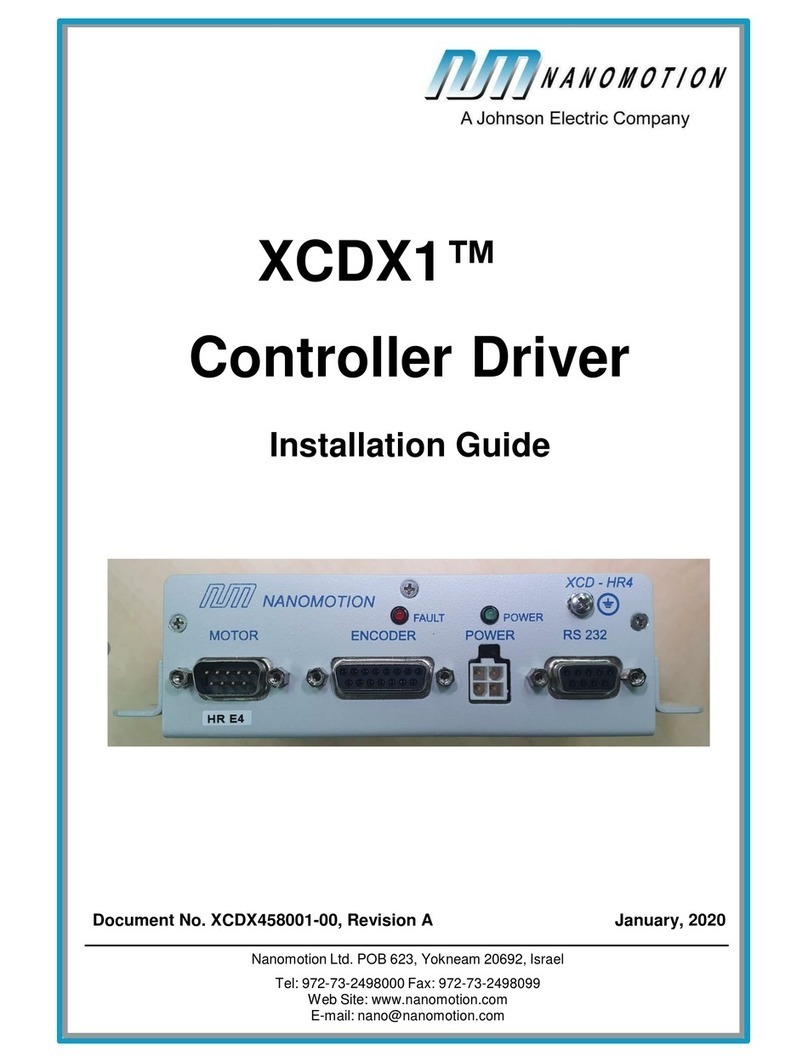
Nanomotion
Nanomotion XCDX1 installation guide

Ingersoll-Rand
Ingersoll-Rand ARO 2752 Series Operator's manual
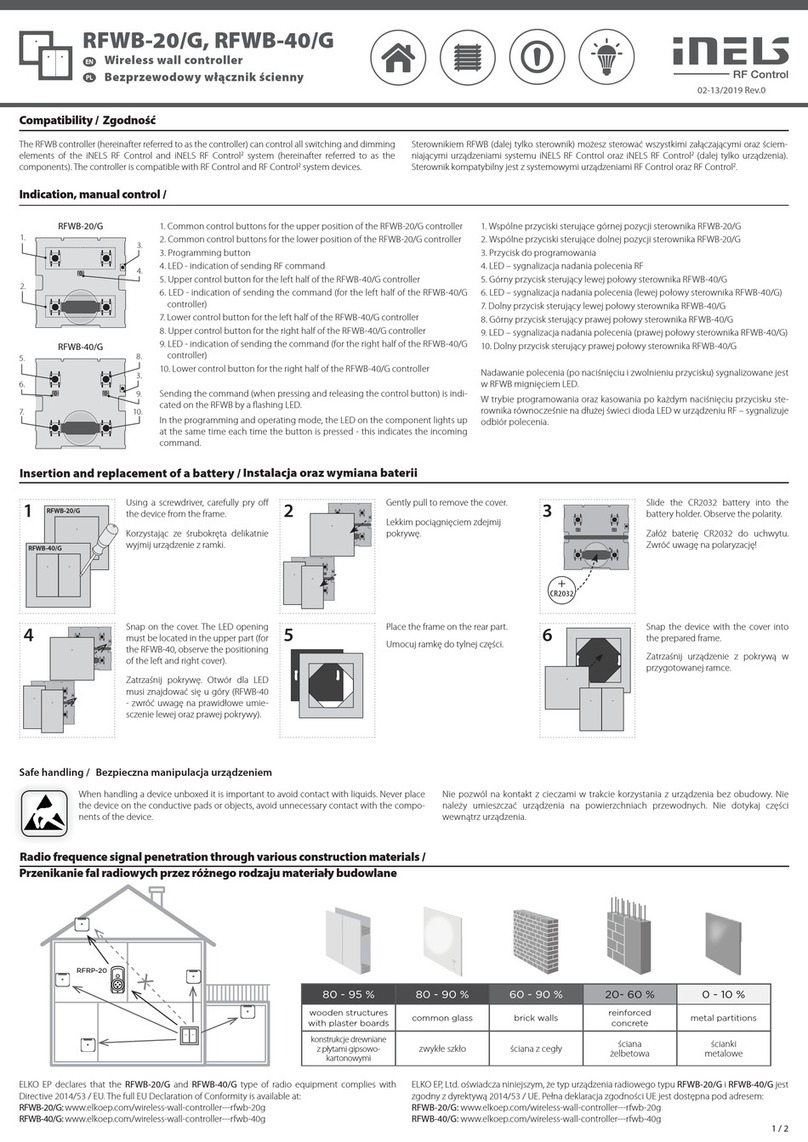
iNels
iNels RFWB-20/G quick start guide

Mitsubishi Electric
Mitsubishi Electric FX3U-64DP-M installation manual
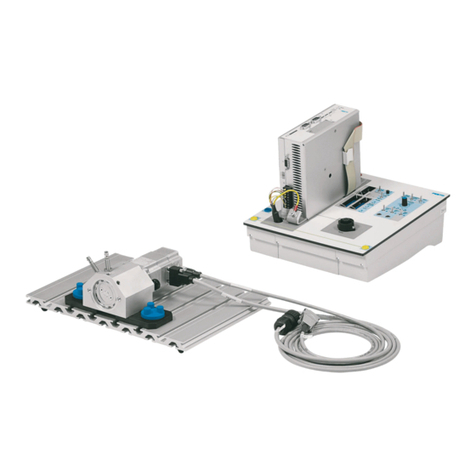
Festo
Festo EduTrainer 571849 operating instructions
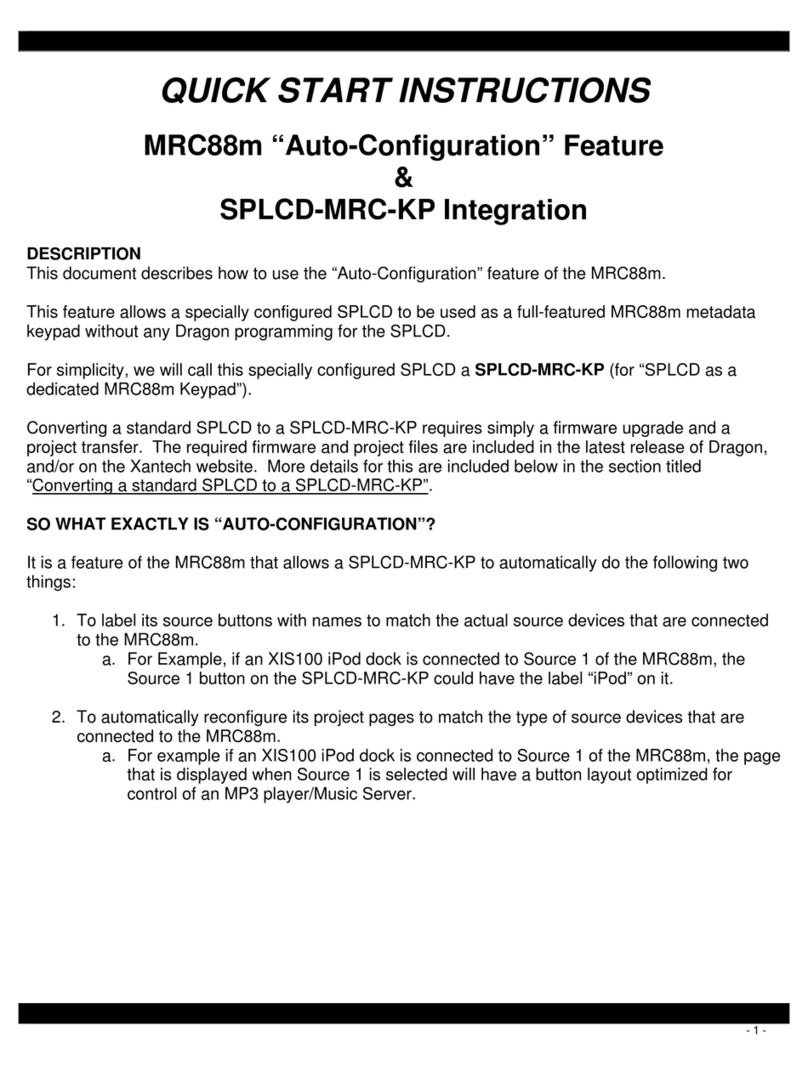
Xantech
Xantech MRC88M Quick start instructions
